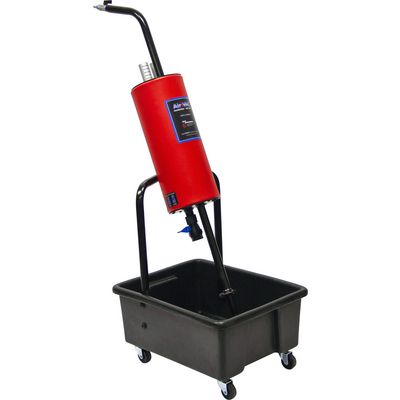
Advantages include very consistent dilution, but it does require higher capital investment than a siphon proportioner. This device, Cross said, uses a water-driven piston to draw product from the drum and inject it at a steady rate into the water stream. Siphon proportioners are relatively low cost and easy to use, Cross said, but can give uneven results.Ī more precise dosing option, at around $1,000 and up, is a positive displacement proportioner. One popular option is a siphon proportioner, which uses Venturi effects to draw the product up a moving water stream. Dosing can be performed through an array of techniques and equipment. Once the water and concentrate variables are understood, the next steps are dosing and mixing. Around 10 to 15 degrees Celsius (50 Fahrenheit) is a good starting point 23 C (74 F) is even better. If you use warm water and warm product, it helps you get good emulsions, he said. This is sharply evident in winter, when intake water can be icy-cold and/or drums may be stored in uninsulated spaces. Higher temperatures will make emulsification easier and faster, while frigid fluids will need more mixing time to form an emulsion. Operators also need to heed the starting temperature of their fluids-concentrate and make-up water alike-when mixing up an emulsion, Cross reminded.

He showed how an emulsions hardness can be magnified through repeated cycles of evaporation and plain-water top-offs: One premium emulsified oil started at 120 milligrams of hardness ions per liter, but with water-only additions quickly grew to have 10 times that hardness, splitting the pricey emulsion. So if you make up using only water, youll increase the hardness at each step. The right formulation can help sidestep these drawbacks, Cross indicated.Īnother consideration is that when you have evaporative losses of your coolant, only the water is evaporating. That said, he cautioned that users need to be aware of a potential downside to purified water: In certain operations it may shorten tool life (as shown in tapping tool test data he presented at a previous STLE meeting with his colleague, John Burke) and increase foam generation. Other advantages of purified water include greater resistance to bacteria and fungi less corrosion reduced concentrate use less mist and better overall stability. Its easier to mix, and youll get smaller particle sizes and better wetting and penetration. Instead, use purified water, urged Cross, who is based in Norristown, Pennsylvania. These soaps do provide lubricity, but the hardness ions also interact with emulsifiers and reduce the products ability to emulsify and stay there long-term. Hard water contains high amounts of dissolved minerals like calcium (Ca) and magnesium (Mg) that combine with materials in the coolant to form soap and residue. Some 80 to 97 percent of the working fluid is going to be water, so water quality is very important, beginning with hardness.


Water is the most important material, after the concentrate, Cross said in his instructive presentation to the Society of Tribologists and Lubrication Engineers in May. And a true synthetic, he explained, is a craft cocktail of chemicals alone, with no oil at all.Īll three types are fortified with emulsifiers, corrosion inhibitors, antifoaming agents, dyes and other useful components, and are ready to mix right out of the drum at water-to-concentrate ratios ranging from 4-to-1 on up to 20-to-1, depending on the application. A semi-synthetic concentrate contains 5 to 50 percent oil, and may be opaque or translucent in blended form. After blending with water, it usually looks milky or opaque. Emulsifiable oil, also called soluble oil, is a concentrate that contains 50 percent to 85 percent oil (petroleum or vegetable). End users typically will deal with three families of coolant concentrates.


 0 kommentar(er)
0 kommentar(er)
